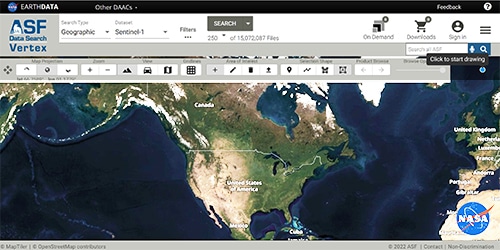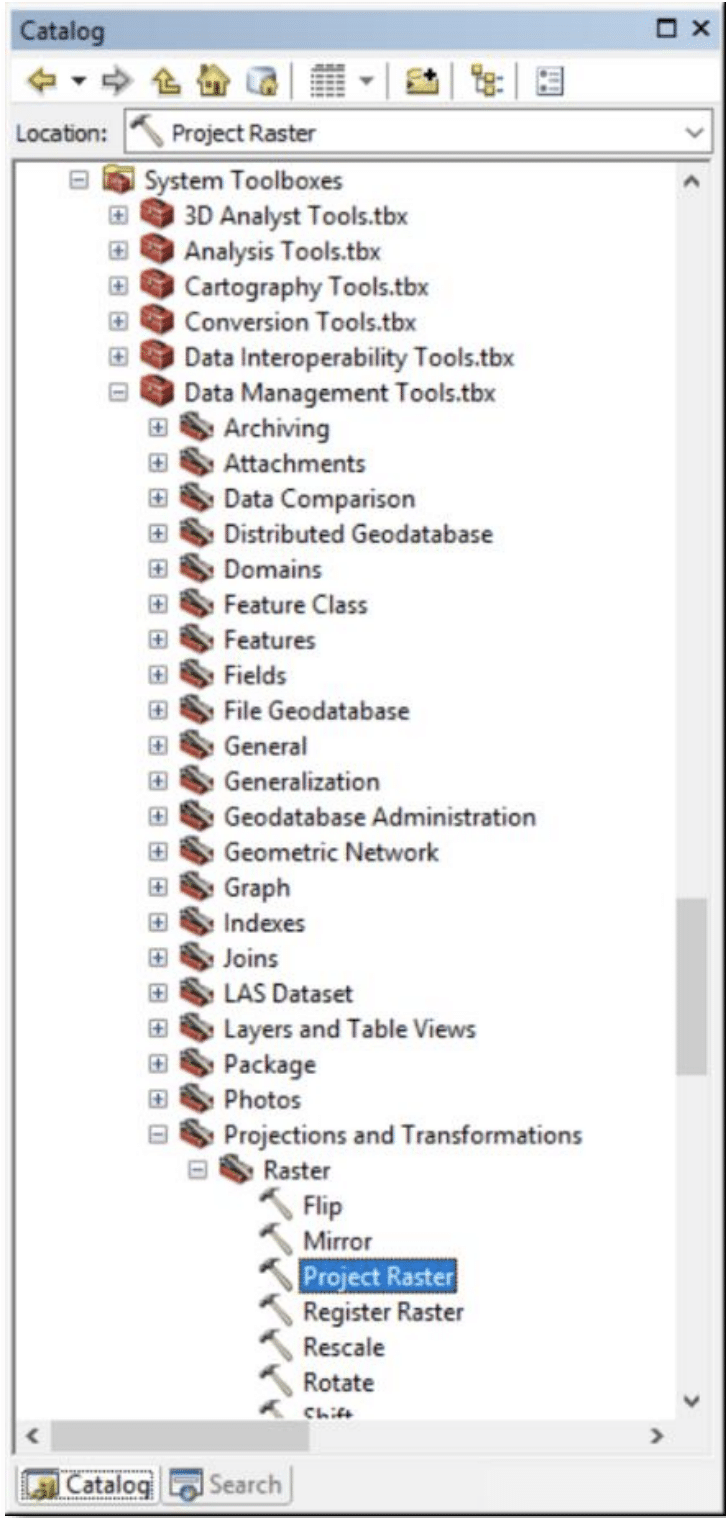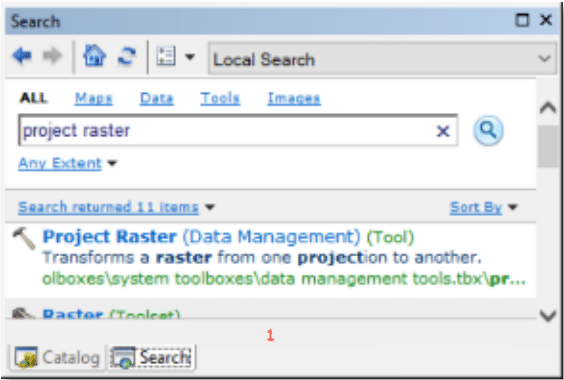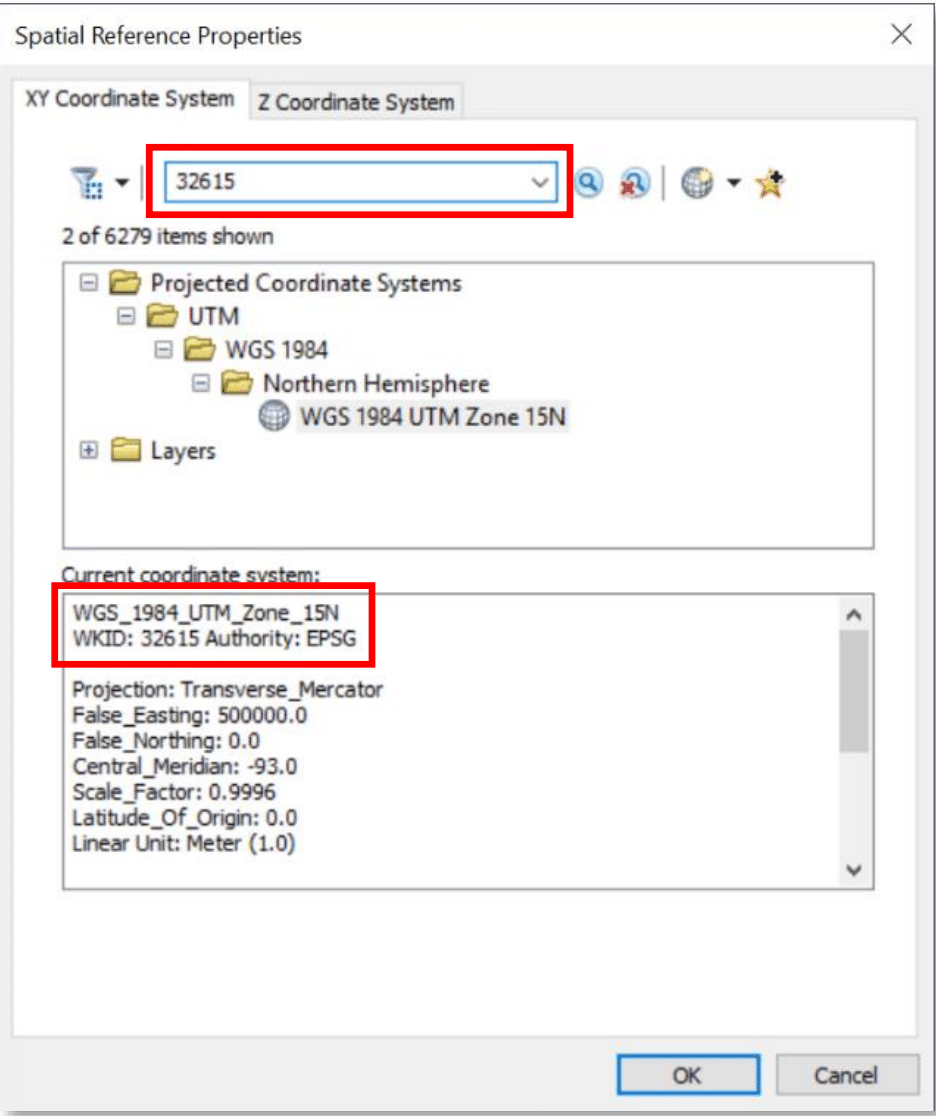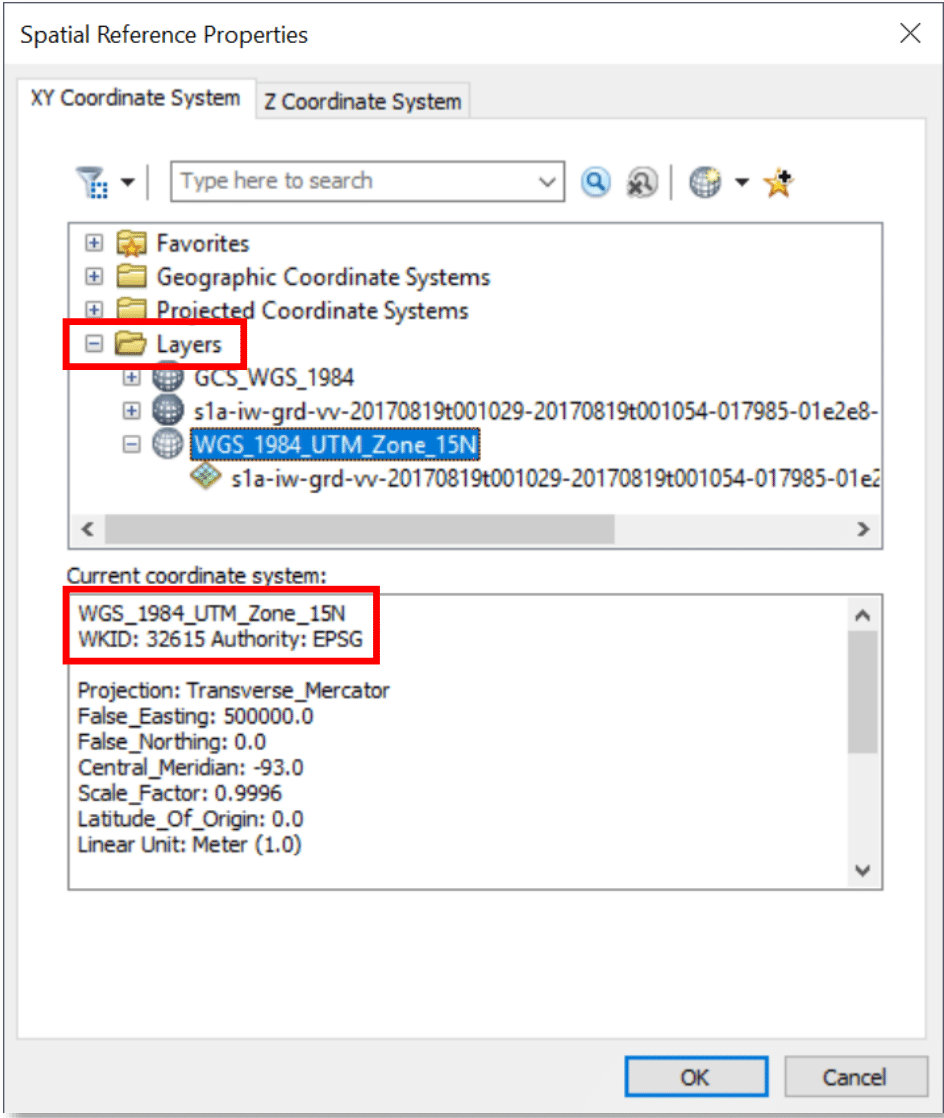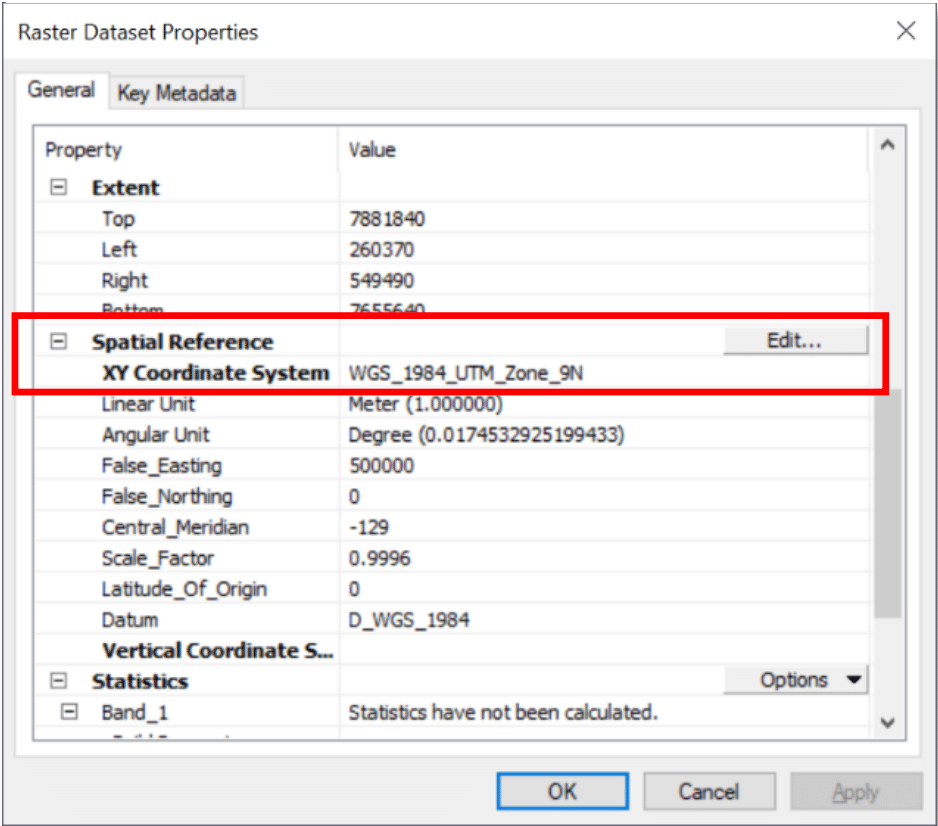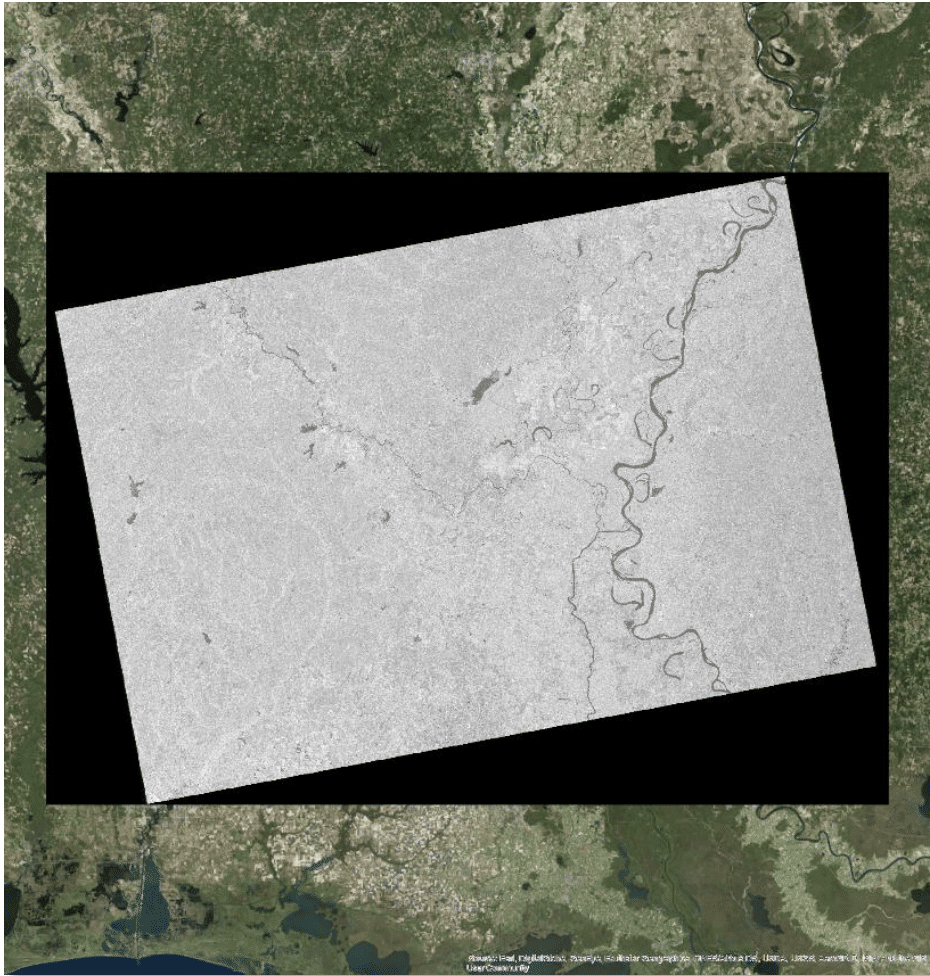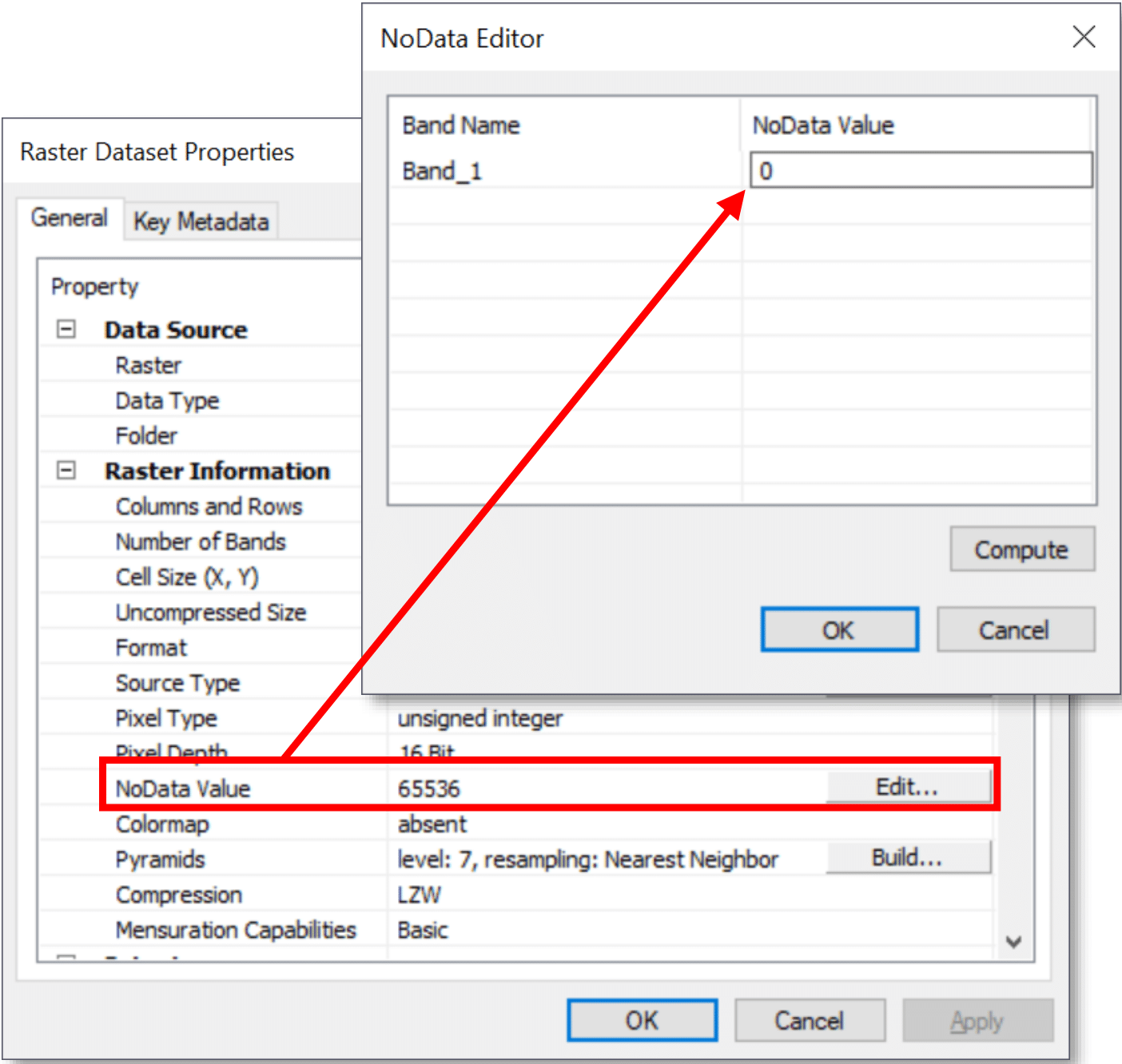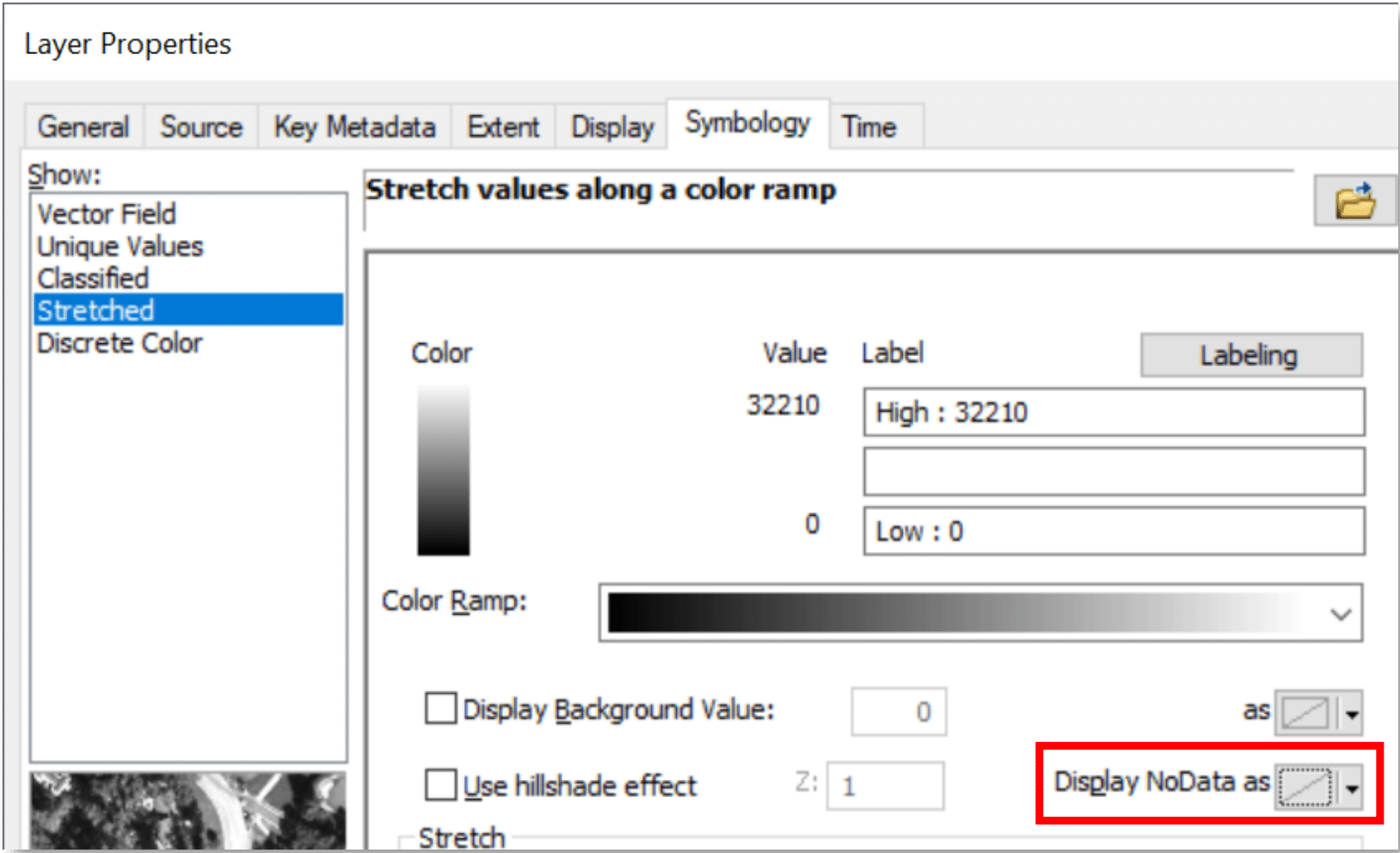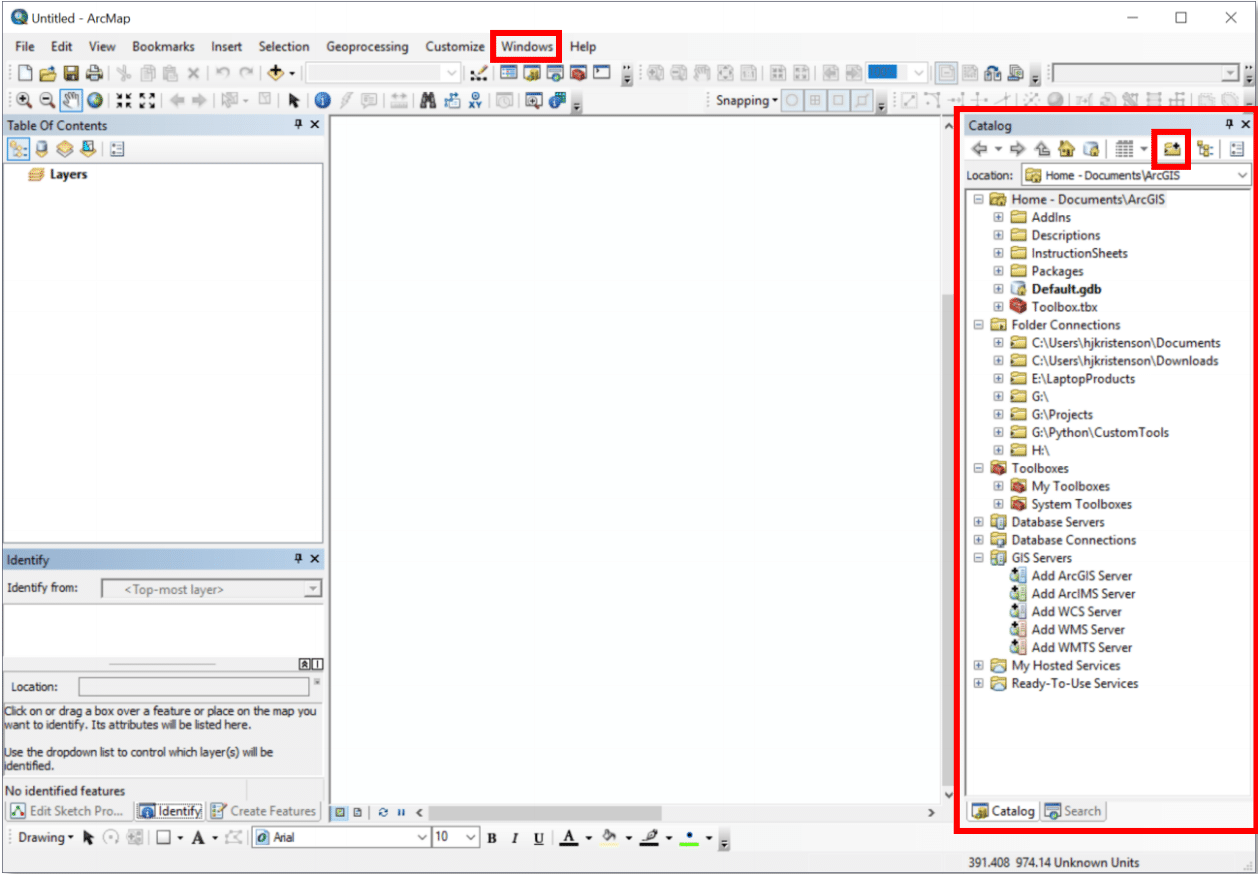This Sentinel-1 image capturing the Mississippi River has been processed into a GIS-compatible format and imported for ease of use. Credit: Copernicus Sentinel data 2017, processed by ESA.
Background
Sentinel-1 Ground-Range Detected (GRD) products are available for download from ASF’s Vertex data portal. These Level-1 GRD products are georeferenced to geographic coordinates using the Earth ellipsoid WGS84, but are still in SAR geometry. By following this data recipe, users will learn how to geocode Sentinel-1 GRD products in ArcGIS using the Project Raster tool. This recipe was tested against ArcGIS 10.6.1 and 10.4, but it should work for earlier 10.X versions as well.
Why Geocode?
Once extracted from their zip file, GRD products downloaded from Vertex can be viewed directly in ArcGIS without any additional steps. The georeferenced TIFF files include the information necessary to allow most GIS software platforms to project the data layers on the fly to match the other layers in your GIS, so you can easily visualize the data without additional effort. If you are visualizing the images outside of a GIS platform, however, the images may appear reversed or rotated. To display the images as you would expect to see them, the image must be transformed from its SAR geometry into a map projection. When working with SAR data, this process is called “Geocoding”.
Geocoding the imagery will ensure not only that the image displays at the correct location on the Earth’s surface in any given application, but that the image will also display as expected when it is viewed outside of a spatially-enabled framework (i.e. north is up, features are not stretched or reversed in unexpected ways).
Even when working within a GIS, if you want to go beyond simply visualizing the data and perform analysis or geoprocessing functions using the GRD granule, it should be geocoded to a map projection first. In ArcGIS, this can be accomplished by using the Project Raster tool. If you would prefer to use GDAL, QGIS 2.18, or QGIS 3.X to geocode, refer to ASF’s Data Recipes for geocoding products within each of these platforms.
Note that using different geocoding techniques/options may result in slight differences in the output products. While one output is not necessarily “better” than another, it is a good idea to be consistent when generating geocoded products for use in the same project, especially if you are looking at imagery from one location through time. The best approach to use will vary depending on the goals and preferences of the user.
Geocoding is NOT Terrain Correction
It is important to understand that this geocoding process does not involve terrain correction. To match the imagery to actual features on the earth and correct for distortions caused by the side-looking geometry of SAR data, you must perform Radiometric Terrain Correction (RTC) instead. This will be particularly important in areas of high topographic variation. Refer to ASF’s Data Recipes on Radiometric Terrain Correction, or contact ASF to learn about other resources for RTC processing
Prerequisites
Materials List:
- ArcGIS Desktop (any licensing level)
- Earthdata login credentials
- If you do not already have an Earthdata account, visit the Earthdata website to register for this free service.
- Download Sentinel-1 GRD data using Vertex.
- When downloading from Vertex, you must either already be logged in to Earthdata, or you will be prompted to enter your Earthdata Login username and password before the download will begin.
- You may use this Sample Granule.
If you choose to download a granule other than the sample granule, you will need to determine an appropriate projected coordinate reference system to use for that location (i.e., UTM zone).
To determine the UTM zone for an unfamiliar granule:
- Add the GRD to ArcGIS (See the Geocoding Steps section for downloading and extracting the granule and tips on adding data to ArcMap).
- In the File menu, select Add Data — Add Data from ArcGIS Online.
- In the search bar, enter “UTM Zones” and click Enter to display the results.
- Find the “World UTM Grid” layer package, served by esri_dm, and click Add.
- No transformation should be necessary, as both should be in WGS84.
- With the Identify tool, click on the UTM grid cell containing your granule to display the World UTM Grid properties for that area.
- Note the ZONE and ROW_attributes.
- The UTM zone number will be the ZONE value, and you must determine if the zone is in the northern or southern hemisphere.
- Northern Hemisphere: Rows N-Z
- Southern Hemisphere: Rows A-M
- Visit the Spatial Reference website and enter your UTM zone in the search field (i.e. “UTM 13N” for zone 13 — northern hemisphere).
- Click the link for the European Petroleum Survey Group (EPSG) code for the WGS 84 entry (i.e. WGS 84 / UTM zone 13N) and verify that its location logically matches your granule.
- Copy the EPSG number for use in step 3.4 in Geocoding Steps — Project your Product of this data recipe.
Geocoding Steps
If you are new to the ArcGIS environment, refer to the Appendix: Working in the ArcGIS Environment, which will introduce you to some key aspects of ArcMap that will be helpful to understand when working through this Data Recipe.
Within the downloaded zip file is a base directory with the name of the granule followed by a .SAFE extension. This SAFE structure contains a number of directories and files, and the data images are saved as georeferenced .tiff files in the folder named “measurement.”
The image we are interested in for this tutorial is the co-polarized GRD:
s1a-iw-grd-vv-20170819t001029-20170819t001054-017985-01e2e8-001.tiff
Note: If you are using a different granule than the sample provided, the co-pol image may be labeled hh instead of vv.
Use your preferred method to extract the desired file from the zipped folder, or refer to the suggestions below.
Unzipping with Windows 10
If you unzip the entire folder with the standard Windows 10 zip utility, there is a good chance that you will exceed the number of characters allowed in a Windows directory path. You can either save the zipped contents to a different folder, or you can just extract the single file as follows:
- Double-click the .zip file in your Downloads folder, double-click the .SAFE file, double-click the measurement folder and highlight the desired .tiff file.
- Under the Compressed Folder Tools menu (which appears when you browse into a zip file), click the Extract button, and select the Extract To… option.
- Select one of the recent folders (which will start the extraction immediately), or use the “Choose Location” option at the bottom of the dialog box to navigate to the desired extraction location and click the Copy button to extract the file.
- The single .tiff file will be extracted from the zipped folder structure.
You may also wish to download the 7-Zip File Manager for a more flexible zip utility than the standard Windows zip utility, especially if you have a Windows operating system earlier than Windows 10.
Project your Product
- Open a new ArcMap project
- Open the Project Raster tool
- You can find this tool in the ArcGIS System Toolboxes, under Data Management Tools > Projections and Transformations > Raster. Double-click to open the tool.
- You can also type “project raster” into the ArcMap Search window (use Ctrl+F to open the ArcGIS Search window if it isn’t already open). Click on the Project Raster (Data Management) name in the results to open the tool.
- Enter the parameters into the Project Raster tool dialog.
- Select your input raster from the dropdown list of project layers (if you added it to your ArcMap project), or click the folder icon next to the field to browse to the image to be projected. (a)
- The input coordinate system will be recognized as GCS_WGS_1984. (b)
- Enter the output file path/name, or click the folder icon next to the field to navigate to the destination directory and type in the name. (c)
Note: Unless you are saving the output to a geodatabase, you must add the .tif extension to the end of the filename.
- Enter the Output Coordinate System. (d)
- Click the projection icon next to the field to open the Spatial Reference Properties window.
- Enter the Output Coordinate System. (d)
The sample granule provided is located in Louisiana, which is UTM Zone 15N (EPSG 32615).
- If you know the EPSG number of the desired projection, you can type that number into the search field and press Enter to locate the projection.
- Click OK to apply the highlighted projection.
- Optional — Enter the Geographic Transformation. (e)
If a transformation is required to project the source coordinates into the output coordinate system, ArcGIS will list the transformations available for the selected input and output coordinate systems as a dropdown menu.
If the datum is the same for the input and output coordinates, there is likely no geographic transformation required. For our sample granule, we are generating a product in WGS_1984_UTM_Zone_15N, and because the input is also in WGS 84 coordinates, no transformation is required.
- Set the Resampling Technique to BILINEAR. (f)
- If desired, you may set the output Cell Size in the X and Y direction. (g)
The output cell size will be in the units of the projection. For example, UTM projections are in meters, so entering 10 for X and Y when projecting to UTM would result in a product with 10-meter by 10-meter pixels.
- Click OK to run the tool. (h)
Other Options for Finding or Selecting Projections
- If you know the name of the coordinate system you want to use, but it is not coming up when you search, you can also navigate through the Projected Coordinate System folder manually to find the desired projection.
- If you have chosen a custom granule to cover a specific area of interest and you have other imagery that has already been projected to an appropriate coordinate system for that area, you can reference the projection information of this other imagery. Add the reference image to your project, open the Project Raster tool, the open the Spatial Reference Properties window as in step 4 above. Expand the Layers folder to select the projection of your reference image. Note that if you have multiple layers in your ArcMap project, all the projections present will be displayed. Expand an entry to determine which layer(s) use that projection. Highlight the correct projection and click OK to apply it.
- You can examine the Spatial Reference of any raster in ArcCatalog to find the projection information:
- Right-click on the layer in ArcCatalog (or in the ArcCatalog window in ArcMap), select Properties, and scroll down to the Spatial Reference section. The XY Coordinate System lists the projection of the layer.
- Click the Edit… button to open the Spatial Reference Properties. The current coordinate system of the raster is displayed, including the EPSG number.
Optional — Set No Data Value
ArcMap does not include an option to set the padding pixels added during the projection process to No Data; by default, they are given values of 0.
If you add a projected image to an ArcMap project, these 0-value padding pixels will display as black by default.
In addition, the ESA granules served by Vertex may also have 0-value pixels added along the edges to mask out garbage values.
To set any 0-value pixels to a NoData value, which can then be easily set to display transparently, use the following steps:
- Navigate to the output .tif file in the Catalog window, right-click on the filename and select Properties.
- Scroll down to Raster Information, and click the Edit button next to the NoData value.
- Highlight the NoData Value, enter 0, and click OK to close the NoData Editor. Click OK to close the Raster Data Properties window.
- Add the new raster layer to your ArcMap project by dragging it from the Catalog window into the Layers window. Uncheck the box in front of the old layer to make this new layer the only one visible.
- Right-click the layer in the ArcMap TOC and select Properties.
- In the Symbology tab, set the Display NoData to No Color
- Click OK to close the Layer Properties. The image will now display with the 0-values transparent.
Note: While most of the black edge pixels are gone, there may be some remaining. ESA has applied different masking approaches to the Sentinel-1 data over time, and not until IPF Version 2.90 (March 2018) were 0-values used to mask all of the garbage pixels along the edges of the GRD images. Applying the NoData designation to 0-value pixels in newer images results in a very clean image without any edge artifacts. You can determine the IPF version used to process your granule by opening the manifest.safe file (included in the download folder for your GRD product) with a text editor (i.e., Notepad) or other XML-compatible software, and searching for IPF. Refer to ESA documentation for more details on masking.
Appendix: Working in the ArcGIS Environment
If you are new to the ArcGIS environment, this section will introduce you to some key aspects of working in ArcMap.
The Catalog Window
Most ArcGIS users work in the ArcMap application. ArcCatalog is an additional ArcGIS application designed for managing datasets, and while some processing tools can be run directly in the ArcCatalog application, ArcMap is better suited to geoprocessing and visualizing spatial data. Over the years, the ArcGIS platform has integrated more and more of the ArcCatalog functions into the Catalog window within the ArcMap application to the point that the Catalog window is nearly equivalent to the ArcCatalog. It is extremely helpful to have the Catalog window open or available when working in ArcMap.
You can open the Catalog window in ArcMap by selecting Catalog from the Windows menu. You can drag the window to place it in your preferred location, or use the pin button in the top right corner of the window to minimize the window to a tab.
The Standard Toolbar also includes a Catalog icon that you can use to open the window.
Folder Connections
You will want to create a folder connection to the directory on your computer that contains your geospatial project data and/or products. You can create a connection to a very specific folder if you will be using it frequently, or you can set a connection to a fairly high level of your directory structure, allowing you to access many less frequently-used folders within that directory from one connection.
To connect to a folder:
- Click the Connect to Folder icon at the top of the Catalog window.
- Browse to the folder you would like to add and click OK.
- You will see the path to your newly-connected folder listed in the Folder Connections section of your Catalog window.
If you find you are no longer needing a folder and want to clean up your list of folders, you can simply disconnect it by right-clicking the connection in the Catalog window and selecting Disconnect Folder. This will not delete the actual folder, but just the connection (basically a shortcut) listed in ArcCatalog. You can always reconnect later if you find yourself needing to access it again in the future.
Adding Data to ArcMap
ArcGIS allows users to drag and drop files into an ArcMap project. While you can do this directly from Windows File Explorer, the safer and often more convenient option is to drag the file from the Catalog window (or double-click it). ArcCatalog (and by extension, the Catalog window) curates data files with ArcGIS applications in mind. You will note that not every file in your directory structure may be displayed in the Catalog, because it will display files in terms of what is useful to ArcGIS.
If you browse to a shapefile in File Explorer, you will see on the order of 7 files with the same basename but different extensions. If you browse to that same location in the Catalog window, the shapefile will appear as a single file, which you can drag into your project and be sure that all of the information necessary to correctly render the shapefile is recognized and accessible by ArcGIS.
Similarly, appropriately-named and formatted auxiliary files containing metadata (.xml) or pyramids (.ovr) for rasters won’t appear in the ArcCatalog structure but will be recognized by ArcGIS as being associated with the appropriate geospatial file, and the contents will be accessed appropriately. In the case of the XML, it can be viewed and edited through the ArcGIS Item Description interface, which ensures that edits are applied in the correct format. If you edit the XML metadata file directly outside of the ArcGIS environment, it may be rendered unreadable by ArcGIS applications.
If you are using or accessing file geodatabase structures in ArcGIS, you will find that no meaningful structure is present when you open the .gdb file in File Explorer; it is a series of hundreds of inscrutably-named files. When you navigate to that same gdb in ArcCatalog, it is neatly organized, with all of the component feature classes and associated files clearly defined and ready for use.
If you are dealing with multi-band rasters, you can either add the entire raster as a multi-band image, or you can expand the raster dataset in the Catalog and import specific bands of interest as individual single-band images. This capability is not available when looking at the raster in File Explorer, where it appears as a single TIFF file.
By adding data from the Catalog window instead of directly from File Explorer, you can be confident that you are adding the appropriate data. You can also add data using the Add Data button in the Standard Toolbar, which browses through your directory structure using the same treatment for files as would be seen in the Catalog window.
The Search Window
Another useful ArcMap Window to become familiar with is the Search window. It can also be opened from the Windows menu, or by clicking the Search icon in the Standard Toolbar.
The Search window is very useful for finding tools because you can type in some keywords and it will return a list of potential tools. You can click the title to open the tool dialog directly or click on the links below to either read more about the tool or locate the tool in the Catalog. You can choose to dock the Search window in the same area as the Catalog window, allowing for easy toggling between the two using tabs.
ArcToolbox
The tools available for use in ArcGIS are all stored in System Toolboxes found in the Toolboxes section of the Catalog window. The toolbox is divided into additional layers of toolboxes and toolsets by topic. If you know exactly where the desired tool is stored, you can navigate through the toolbox “folder” structure to locate your tool and double-click it to launch the tool dialog. Because there are hundreds of tools, however, and many levels of organization (some more intuitive than others) in the System Toolbox, it is often easier to find the tool by using the Search window described above.
You can also open an ArcToolbox window in ArcMap, which has the same contents as the System Toolboxes directory in the Catalog window. Click the ArcToolbox icon in the Standard Toolbar to open it directly.
If there are tools you find yourself using over and over, you can create your own toolbox by right-clicking in the desired target directory in the Catalog window and selecting New — Toolbox. You can copy and paste tools from other toolboxes to create your own collection for easy reference, rather than having to search each time.
Geoprocessing Results
The Results option in the Geoprocessing menu is a useful reference. When you run a tool, the results window will display the tools that you have run since opening that instance of ArcMap. You can expand each entry to look at the parameters you entered, and any messages generated during processing. This can be especially helpful if a process fails and you want to investigate it more fully.
When processing is complete, a small popup appears in the bottom-right corner of your screen, letting you know if the process was successful or if it failed. Clicking on the link in that popup will also open the Results window.
If you want to run a process again with slightly different parameters, open the Results pane, expand the Current Session section, and double-click the process you would like to repeat. The tool dialog will open, prepopulated with the parameters you used when you ran it. Make the desired changes, and click OK to run the tool again with your new parameters.
Visualizing SAR Data
You may wish to change the way an image is displayed, especially if it is too dark or washed out to see features clearly. Because the Sentinel-1 GRD products are displayed with amplitude values, they will usually display well in GIS environments; this is more of an issue when viewing datasets with power values. In any case, you can use the ArcMap stretch settings to display the image with a different level of contrast without changing the data or having to generate a new image.
- Right-click on the image layer in the Table of Contents, select Properties
- In the Symbology tab, under the Stretched option, experiment with the different Type options. The default is Percent Clip, but you may prefer Standard Deviation, Sigmoid, Histogram Equalize, or Minimum-Maximum.
- Many of these options have different parameters; experiment with different values to see which settings bring out the features of interest in your image. For example, the default setting for Standard Deviation is 2.5, but you may find that a different value is more appropriate for the range of values in your image.
- Click Apply to see how your changes affect the image. When you decide on a setting you like, click OK.
- When using the Identify tool on a stretched image, the main Identify window will still display the original power value. The expanded feature properties will display both the Stretched value and the original pixel value.


